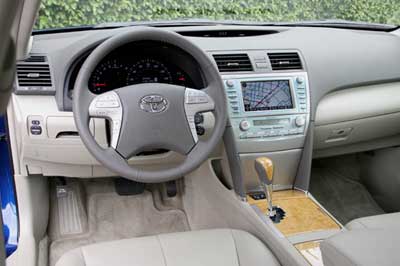Recent Articles
Popular Makes
Body Types
2007 Toyota Camry Review
Proving that, indeed, no car company’s perfect
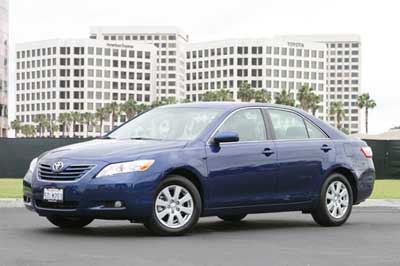
“It’s a Toyota.” This simple phrase has made life easy and profitable for Toyota salespeople, made domestic car manufacturers green with envy, and has bred such confidence in Camry and Tacoma owners that they border on arrogant. Historically, Toyota buyers have often been justified in this smug sense of superiority – if you were smart, you would’ve bought a Toyota, too. It’s your own damn fault that you’re missing work again to sit at the (insert non-Toyota brand name here) dealership waiting for your car to get fixed. Burned by a Chevy? Buy a Toyota. Ford dealer treating you poorly? Buy a Toyota. Need a wagon? SUV? Compact? Buy a Matrix, or a Highlander, or a Yaris, all by Toyota. Need a full-size truck? Wait for the redesigned Tundra, the unofficial Second Coming, via Texas and courtesy of Toyota. That’s how things have been in the automotive arena for quite some time, though Toyota’s most recognizable nameplate, the Camry, may cause some buyers to pause – maybe just for a millisecond – before adding themselves to the ranks of the saved. Specifically, quality concerns with our $31,000 XLE V6 test car, as well as similar and consistent issues we’ve noted with other recent Toyota products, should cause the eternal green sales light to flicker. At the same time, domestics are continually improving quality, most evident in redesigned cars and trucks from the “Detroit Three” that have arrived in recent years. Could it be that the quality playing field is leveling out? Perhaps, but “It’s a Toyota” still means that, in all likelihood, the thing will probably run forever with routine maintenance and it might even be worth something after all three of your high school kids have beaten it into the ground. However, look at the details of that shiny 2007 Camry on the lot, the one priced north of $30,000, and you might discover that those simple words don’t go as deep as you’d like. Buyers interested in the most fuel-efficient 2007 Toyota Camry will want to opt for one with the smaller engine. The aluminum 2.4-liter four-cylinder features dual overhead cams, 16-valves, and a horsepower rating of 158 at 6,000 rpm backed up by 161 lb.-ft. of torque at 4,000 rpm. In most states, this engine gets an ultra-low emissions vehicle rating, but in so-called green states (Maine, New Hampshire, Vermont, Massachusetts, Connecticut, Rhode Island, New York, New Jersey, California) it gets a partial-zero emissions rating that drops horsepower to 155 and torque to 158 lb.-ft. When mated to a five-speed manual transmission, the front-wheel-drive Camry boasts 24 mpg city and 34 mpg highway; a five-speed automatic cuts the highway rating to 33 mpg. Achieving an estimated 22 mpg city and 31 mpg highway is an available 3.5-liter, aluminum V6 joined to a six-speed automatic. This six-cylinder engine features 24 valves, dual overhead cams, 268 horsepower at 6,200 rpm, and 248 lb.-ft. of torque churning at 4,700 rpm. Regardless of powertrain, all 2007 Toyota Camry models feature antilock disc brakes aided by electronic brake-force distribution; rack-and-pinion steering, and a suspension system comprised of MacPherson struts in front and a dual-link setup in the rear. There are several Camrys to choose from:
Driving Impressions
Ron Perry’s 2007 Toyota Camry Driving Impressions: The highlight of the 2007 Toyota Camry driving experience has to be the great acceleration. The V6 pulls hard with lots of torque from any speed and rpm. There is a delay when asking for passing gear from the automatic transmission, but the wait is worth the pending acceleration. Shifts from the transmission are smooth and seamless, but I do feel the engine is a little buzzy at higher revs. However, at freeway speeds, the revs are low enough to not bother you. There did seem to be a lot of tire noise in the cabin that I didn’t expect to hear on a car of this caliber but wind noise was minimal. The steering needs to be more taut to suit my tastes, but the brake feel was dead on. The Camry also exhibited slight torque steer under hard acceleration that shouldn’t be there. The view out the windows and mirrors wasn’t obstructed and there were no blind spots to deal with so navigating through traffic was easy. The biggest disappointment was the lack of a luxurious feel and the low quality craftsmanship that is apparent. Thom Blackett’s 2007 Toyota Camry Driving Impressions: Spend a few minutes in the 2007 Camry, and you’d swear that Toyota builds a better Buick than Buick. Unlike the relatively sporty Honda Accord, this Japanese-branded family sedan offers negligible amounts of road feel, rides on a pillowy suspension, and features over-boosted steering at all speeds. Those characteristics are fine for around town, and to some degree even appreciated, but it all translates to a ponderous cruise on the freeway. Ironically, the new Buick Lucerne offers a more engaging driving experience. Check out the Camry SE if you’re looking for a sprinkling of athleticism. Under the sculpted hood is a strong V6 engine providing plenty of get-up-and-go. However, the throttle’s sensitivity may be detrimental when drivers tap the gas and subsequently take off like a bat outta hell. The six-speed automatic transmission is basically seamless in its operation, though it can hiccup a bit when accelerating from a slow roll. Get up to speed and notice the soft ride that absorbs bumps and road abnormalities with ease. After an aggressive test drive, the brakes proved effective and soldiered on fade-free; full-on braking at high speed felt solid and secure with just a hint of shudder from the ABS system. Christian Wardlaw’s 2007 Toyota Camry Driving Impressions: Driving the 2007 Camry is the best thing about Toyota’s redesigned bread-and-butter sedan. Its new 3.5-liter V6 is strong and energetic, its six-speed automatic shifts decisively between detents and smoothly between gears, and the suspension is a terrific compromise between ride quality and responsiveness. The Camry’s steering requires little effort to twirl but never feels sloppy, the brakes respond instantly to input and prove easy to modulate, and the tires grip decently if not quietly. Indeed, most people who buy a new 2007 Toyota Camry with the available V6 engine will find it to be powerful yet efficient – we averaged 22.3 mpg with regular dips into the throttle. Though our XLE-trimmed test car wasn’t entirely engaging, neither was it entirely boring. What more should a Camry deliver? Quiet, for one, and our Camry was not quiet inside. At idle, valvetrain noise gets into the cabin, and once underway, the engine exhibits a whine not unlike that of a General Motors V6. Refinement doesn’t seem to be a strong point with this engine. Add in the irritating wind noise that seems to be coming from the windshield wiper arms, and the significant road rumble coming up through the floor, and the Camry is much louder inside than expected.
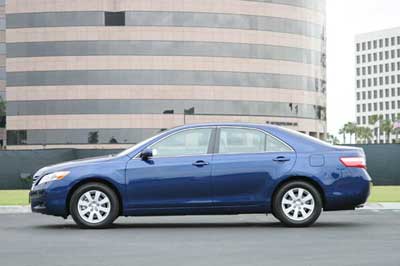
Comfort
Ron Perry’s Opinion of the 2007 Toyota Camry’s Comfort: The 2007 Toyota Camry’s driver’s seat is very comfortable but lacks bolstering on the bottom or back cushion. The electric controls on the seats and the tilt wheel allow for multiple position variations so finding a comfortable seating position is easy. There are also seat heaters to add to the comfort on cold mornings. Up front there’s lots of head room and plenty of pedal space for your feet, including a large dead pedal for resting your left foot. The Camry’s ride is a little stiff, which would take its toll on me over the course of a long journey. In the back, entry space is limited but once inside there is plenty of head, knee and foot room to go around. The large bench seat is comfortable even for the poor guy who draws the short straw and has to sit in the middle. A fold-down center console with sturdy cup holders adds to the comfort as do the two air vents located in the rear of the center console. The Camry also offers a low liftover to the trunk for easy loading. Thom Blackett’s Opinion of the 2007 Toyota Camry’s Comfort: Given the 2007 Toyota Camry’s Buick-inspired driving character, it stands to reason that the interior would likewise provide comfort. Our XLE V6 test car featured supple leather on the soft seats, and padded door armrests and window sills, but hard plastic rubs against the driver’s knees in quick corners. Front passengers are treated to wide, spacious buckets that lack decent bolstering (let’s hope the NASCAR Camry drivers get better support) and surround a padded, sliding center armrest. Drivers wrap their hands around a wood-and-leather shift knob and a leather-wrapped steering wheel that tilts and telescopes. Buttons for the radio and air conditioning are on the steering wheel spokes, while the cruise control is on the backside of the wheel. There’s a button forward of the shifter for the heated seats, but they don’t offer multiple heat settings like many competitors. Only the driver’s window and sunroof feature one-touch opening and closing. Entering the rear of the 2007 Toyota Camry requires sinking down a bit to the bench’s low height, yet once seated occupants enjoy the reclining feature, three large adjustable headrests, a padded fold-down center armrest, and ample foot, leg, and head room. Less pleasant are the hard front seatbacks and exposed lower seat frames – GM started covering up these unsightly bits for the 2007 model year. The center section of the rear bench has a dedicated headrest and is fine for short distances, but it’s flat and uncomfortable, so leave that spot for the passenger you like the least. Christian Wardlaw’s Opinion of the 2007 Toyota Camry’s Comfort: Never before have I been comfortable behind a Camry’s steering wheel. Either the seat was too mushy, or there wasn’t enough leg room, or I couldn’t find the right combination of thigh support and wheel adjustment. I’m happy to report that with the redesigned 2007 Toyota Camry, comfort is king – at least up front, and especially in the driver’s seat. I had no trouble at all finding a perfect driving position in our test car, and my comfort was increased thanks to the softly padded center console that slides fore and aft, and the soft material on the upper door panels which makes for a good spot to rest an elbow while cruising down the highway. However, the front passenger’s seat lacks a seat height adjuster. Am I expecting too much in a $31,000 sedan that I find this to be a blatant oversight? I don’t think so. Strangely, the Camry’s rear seat is less comforting than what I remember of the old model. The bottom cushion seems lower to the ground, with less thigh support and tighter leg space. It’s not cramped at all, just less accommodating than before. Loading cargo requires lifting items over a somewhat high bumper and trunk sill into a large luggage area. Toyota has chosen a rather inexpensive lining for the trunk, and the gooseneck hinges, though small, could still damage contents if the compartment is packed full. Also, note that the Camry does not offer a trunk close assist handle on the inside of the lid. Am I expecting too much in a $31,000 sedan that I find this to be a blatant oversight? I don’t think so.
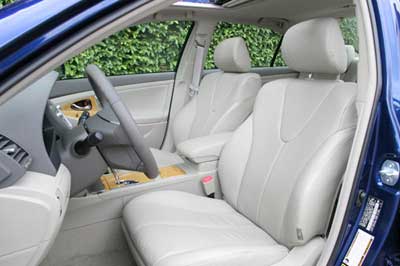
Quality
Ron Perry’s Opinion of the 2007 Toyota Camry’s Quality: Surprisingly for a Toyota, there were several quality issues I noticed upon inspection of the Camry. On the exterior, I found hood gaps that varied from side to side, the gaps where the A-pillar met the fenders varied in size, and a strip of black window trim was coming un-glued and was bowing out. Inside, the bad news continued. The small door behind the shifter was poorly centered and the instrument panel displayed gaps around its perimeter. Several parts weren’t flush where they came together and the A-pillar covers felt loose and sloppy. I also felt a better grade of plastic could have been used on the interior surfaces, which would have helped rid the Camry of the rental car feel that plagues many midsized sedans. Honestly, I was surprised to see this many quality issues with a Toyota. Thom Blackett’s Opinion of the 2007 Toyota Camry’s Quality: No car with a $31,000 price tag, regardless of whether it’s a Chevy or a Toyota, should exhibit the kind of quality issues we found with our 2007 Camry XLE V6 tester. Among the points most notable were irregular gaps on the sides of the dash; a dash cap that was lifting by the side vents; sections around the instrument panel that were not flush; inconsistent gaps around the glovebox and the cubby forward of the shifter; loose pillar covers; a squeaky shifter plate cover; open spaces between the rear door plastic panels and the leather inserts; multiple grain patterns throughout the cabin; and a fuzzy headliner in lieu of preferred mesh. To its credit, this Camry featured soft leather, a light-colored wood that only I seemed to appreciate, and soft plastic on the dash. But, c’mon people, this is a Toyota Camry, the godly car pointed to for decades as a shining example of what imports were doing right and Detroit was fouling up – namely, building a quality vehicle. Based on the details of several Toyotas we’ve recently evaluated, including this Camry, it’s obvious that times have changed. Buyers blindly opting for Toyotas based on reputation owe it to themselves to thoroughly inspect their chosen model before signing on the dotted line. Christian Wardlaw’s Opinion of the 2007 Toyota Camry’s Quality: For years, our editors have been noticing a general degradation of build and materials quality in Japanese cars, but we’ve always written such observations off as oddities given the exceptional attention to detail these brands have historically exhibited. With our test sample, a 2007 Toyota Camry XLE V6 with less than 3,000 miles on the odometer, it’s time for us to stop making excuses. This test sample, more than any in recent memory, served to underscore that the domestics have made great strides in build quality, while vaunted brands like Toyota are beginning to struggle. The assembly and materials quality of our test car was worse than some recent General Motors products we’ve evaluated, certainly not up to the standards one expects with a $31,000 price tag and definitely not up to snuff compared to a Hyundai Azera that was in our parking lot the same week as the Camry. There is no excuse for the numerous problems with panel fits found inside and outside of our test car. Our Camry constantly creaked and squeaked and rattled inside. The plastic used for the back of the steering wheel spokes and the sides of the center console emitted that same hollow, cheap rasp when fingernails scraped across it as that for which we’ve excoriated Chrysler, Ford, and General Motors countless times in the past. The leather was stiff and cheap feeling, the paint displayed an orange peel finish at a glance, the dash pad fit poorly around the driver’s side air vent, and with just a twist of my wrist the passenger A-pillar trim popped off in my hand. I’ve got a litany of little problems that I uncovered with the Camry, from the flushness of fit of the front speaker grilles to the inconsistent finish of the headliner at the plastic C-pillar trim panels, but space is short. We’ve come to expect this kind of indifferent assembly from the former Big Three automakers – in particular General Motors. But after taking a close look at the way our 2007 Toyota Camry was assembled and the materials used in its construction, and comparing these observations to the sticker price and what we uncovered in as thorough a probe of that $27,000 Hyundai Azera we test drove the same week, I have no other choice but to conclude that Toyota has lost its Camry mojo.
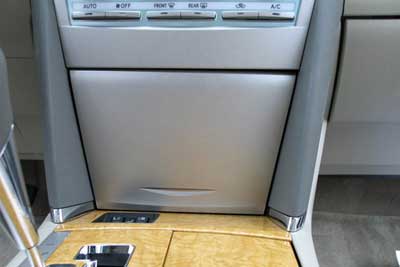
Design
Ron Perry’s Opinion of the 2007 Toyota Camry’s Design: The 2007 Toyota Camry’s exterior is reasonably handsome but nothing to jump up and down about. In fact, I feel there’s too much body color trim and not enough chrome to serve as accenting, especially on a color like the dark blue we had. The design also blends well into a crowd of other midsize sedans cruising down the freeway. From a design aspect, there is nothing about the Camry that sets it apart from the competition. Inside, the Camry looks like the equivalent of a designer food fight took place – and nobody won. There is fake wood here and not there, blue-green trim surrounding the radio and climate controls but located nowhere else, and metallic plastic trim mixing it up with both elements. Had the designers included the wood on the steering wheel and put a strip over the glove box, the interior would have had a more luxurious look and feel to it. The blue-green plastic would have even worked had they done this. The stylist did a great job with the lines and shapes of the dash and door panels, they just weren’t finished out very well. Designers did include a lockable pass-through to the trunk – a nice touch. Thom Blackett’s Opinion of the 2007 Toyota Camry’s Design: Y’all need to come around to the light-wood side. That’s what was used to decorate the cabin of our 2007 Toyota Camry test car, a fact that, based on a thoroughly unscientific poll taken around the office, apparently only pleased me. When coupled with a tan interior and used conservatively, the pale stuff looks more realistic and natural, much better than that fake, dark junk tacked into many pseudo entry-luxury vehicles. Oh, well – to each his own. Other than the aforementioned fake timber product, the 2007 Toyota Camry’s interior includes its share of hits and misses. There are textures pleasant to the touch, soft and curved shapes, and controls within easy reach. Subtle chrome accents are used with restraint, puddle lamps on the doors assist with late night entry and exit, and several storage points are afforded to the front seat passengers. On the other hard, there are no pockets on the rear doors, the large trunk’s lid lacks an assist handle and uses hinges that can impact cargo when closed, and the so-called Plasmacluster instrument panel looks cool with its bluish-green light at night but fails to blend with the rest of the dash. Outside, the look is attractive to some, perplexing to the rest of us. That tiered, bubble butt first scorned on the BMW 7 Series has made its way to the most vanilla nameplate in the business, Camry, whereas the front gets overflexed haunches simulating the raised back of a terrified cat. Pretty. Maybe the idea was to blend some chocolate into the Camry’s bland ice-cream demeanor. Problem is, I don’t think that’s chocolate… Christian Wardlaw’s Opinion of the 2007 Toyota Camry’s Design: Try as I might, I can’t cozy up to the 2007 Toyota Camry’s styling. Designers got tired of hearing people call the Camry boring, and wanted to spice things up with the 2007 model, which unfortunately strikes me as a puffed-up Corolla wearing oversized shoulder pads, a Citroen-influenced nose and a BMW bustle butt. Check out that reverse character line aft of the front wheel wells, just like a BMW X5. Check out that giant Toyota badge dripping down off the hood onto the grille, needing only a chevron to look totally French. Check out that cheesy chrome surround for the grille, which looks like a trail of silver toothpaste. Check out those 16-inch wheels. Sixteens! On a $31,000 pseudo-luxury sedan! In 2007! The larger, and not much more expensive, Toyota Avalon is a much better looking car. Inside, the Camry is more stylish than ever, but it’s also busy in comparison to the outgoing model, with too many obvious panel joints. One of our staff members said the fake maple wood looked like an aftermarket kit that someone glued onto random interior panels during a Saturday afternoon driveway project, and I can see his point. Overall, the Camry XLE’s interior looks and feels cheaper than a Honda Accord, and much cheaper than a Hyundai Azera. Am I expecting too much in a $31,000 sedan that I want automatic up and down functionality for more than just the driver’s window? Am I expecting too much in a $31,000 sedan that the power mirror controls and secondary window buttons should be illuminated at night? I don’t think so. Finally, let me just say that I hate push-button starters. This technology is only useful for someone who carries a purse or briefcase everywhere, and even then the driver is always wondering where the damn key is. At least the Camry offers a storage slot for the fob on the inner panel of the center console, a location not easily accessed by an angry spouse looking to make an expensive and time-consuming point by tossing it out the window and into the woods. Personally, I prefer to have the key in the ignition slot.
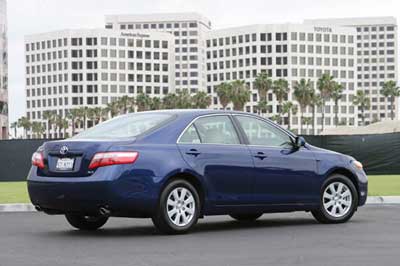
Advice
Ron Perry’s Advice about the 2007 Toyota Camry: Personally I would pass on the 2007 Toyota Camry. With more appealing cars on the market from Honda and Hyundai, I feel you can get a better deal not only on a car that looks and feels nicer, but in the case of the Hyundai is backed with a better warranty. The Azera, for instance, is heads and tails above the Camry in style and refinement. Granted, you aren’t getting the reputation of Toyota reliability and resale value, but you will make it up in driving pleasure and comfort. Thom Blackett’s Advice about the 2007 Toyota Camry: A few generations back, Camry style was admittedly on the plain side, though there were some clean lines, attractive styling cues, and when outfitted with alloy wheels and a subtle rear spoiler, Mom and Dad even felt OK driving it. Plus, it was a good car. For 2007, that same car has been transformed into an odd-looking boat that goes fast but handles like, well, a boat. Mirroring the slide in design is the less-than-stellar build quality. All that for an as-tested price of $31,039? I don’t think so. Hello, Mr. Honda Accord dealer… Christian Wardlaw’s Advice about the 2007 Toyota Camry: Toyota is not invincible. After two decades of progressively better Camrys, the company stumbles with the 2007 redesign. This car, with the exception of a driver’s seat that accommodates my comfort needs and an appreciated fine-tuning of the mechanicals, is not an improvement over the one it replaces. Sure, it’s more powerful and a more pleasing car to drive, but it’s less refined and the quality of construction and materials is disappointing, especially on the $31,000 XLE V6 version we drove for a week. Maybe the new Camry Hybrid, or the sport-tuned Camry SE, will win me over. Until I’ve had a chance to sample those, however, I find myself unable to recommend this new Toyota when so many less expensive and better midsize cars are available for the taking.
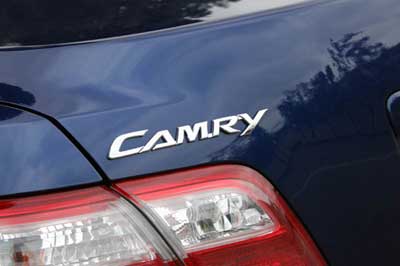
Specifications
Test Vehicle: 2007 Toyota Camry XLE V6 Price of Test Vehicle: $31,039 (including a $580 destination charge) Engine Size and Type: 3.5-liter V6 Engine Horsepower: 268 at 6,200 rpm Engine Torque: 248 lb.-ft. at 4,700 rpm Transmission: Six-speed automatic Curb weight, lbs.: 3,495 EPA Fuel Economy (city/highway): 22/31 mpg Observed Fuel Economy: 22.3 mpg Length: 189.2 inches Width: 71.7 inches Wheelbase: 109.3 inches Height: 57.5 inches Leg room (front/rear): 41.6/38.3 inches Head room (front/rear): 37.9/37.8 inches Max. Seating Capacity: Five Max. Cargo Volume: 14.5 cubic feet Competitors: Buick LaCrosse, Buick Lucerne, Chevrolet Impala, Chevrolet Malibu, Chrysler 300, Dodge Charger, Ford Five Hundred, Ford Fusion, Honda Accord, Hyundai Azera, Hyundai Sonata, Kia Optima, Lincoln Zephyr, Mazda 6, Mercury Milan, Mercury Montego, Mitsubishi Galant, Nissan Altima, Nissan Maxima, Pontiac G6, Pontiac Grand Prix, Saab 9-3, Saturn AURA, Subaru Legacy, Suzuki Verona, Volkswagen Passat, Volvo S40
Photos by Ron Perry
